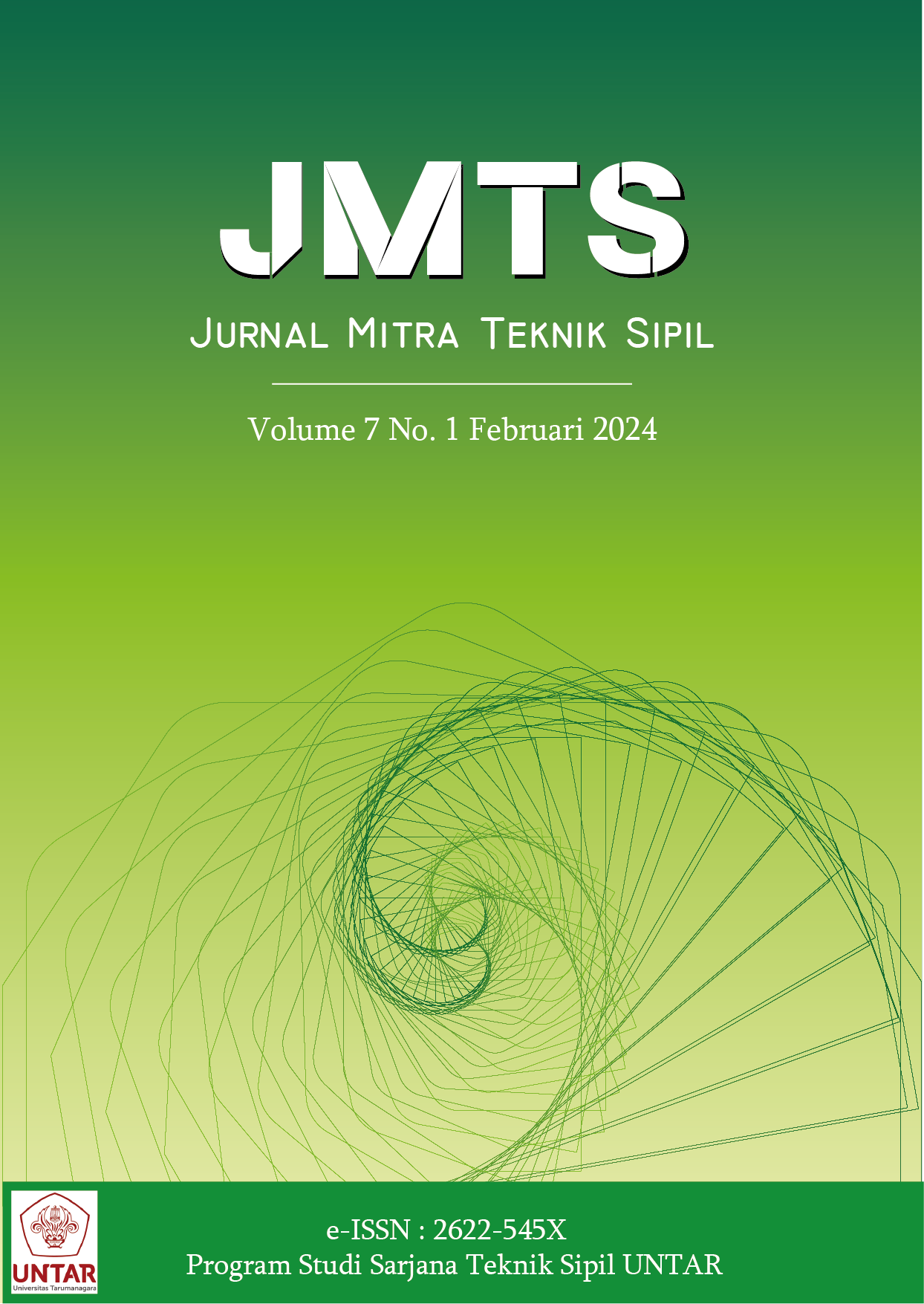ANALISIS DAMPAK INFRASTRUKTUR JALAN TOL SOROJA TERHADAP PERTUMBUHAN BISNIS KECIL DAN MENENGAH
Main Article Content
Abstract
Toll roads are one of the important priorities for the country because toll roads can facilitate the community in supporting the economic growth of an area. Toll roads facilitate accessibility, causing a high level of interaction between regions. This ease of accessibility is felt by small and medium businesses. Small and medium businesses help the growth of Gross Domestic Product (GDP). Toll roads can also have a negative impact on small and medium businesses in a region. This research wants to look at the objective aspect of the project life cycle of a construction plan based on the Project Management Body of Knowledge. Civil engineers are expected to not only focus on the construction phase but also look at aspects that exist in a project life cycle. This study is to determine the economic characteristics influenced by toll road infrastructure development and analyze the characteristics of small and medium businesses. The data used in this research is questionnaire data. Questionnaire data will be processed using a statistical program with validity test, reliability test, and factor analysis. From the output obtained, the factors formed will be based on existing variables, namely X1.5, X2.1, and X3.2.
Abstrak
Jalan tol menjadi salah satu prioritas penting bagi negara karena dengan adanya jalan tol dapat memudahkan masyarakat dalam mendukung pertumbuhan ekonomi suatu daerah. Jalan tol memudahkan aksesibilitas sehingga menyebabkan tingkat interaksi yang tinggi antar wilayah. Kemudahan aksesibilitas ini salah satunya dirasakan bagi bisnis kecil dan binis menengah. Bisini kecil dan menengah membantu pertumbuhan Produk Domestik Bruto (PDB). jalan tol juga dapat menjadi dampak negatif bagi bisnis kecil dan binis menengah suatu wilayah. Penelitian ini ingin melihat aspek tujuan dari project life cycle suatu perencanaan konstruksi yang didasari oleh Project Manajement Body of Knowledge. Insinyur sipil diharapkan tidak hanya berfokus pada tahap konstruksi saja tetapi juga melihat aspek-aspek yang ada dalam suatu siklus siklus hidup proyek. Penelitian ini adalah agar dapat mengetahui karakteristik ekonomi yang dipengaruhi pembangunan infrastruktur jalan tol dan menganalisis kondisi karakteristik bisnis kecil dan binis menengah. Data yang digunakan dalam penelitian ini yaitu data kuesioner. Data kuesioner diolah menggunakan program statistik dengan uji validitas, uji reabilitas, dan analisis faktor. Dari output yang didapat faktor yang terbentuk berdasarkan variabel yang ada yaitu X1.5, X2.1, dan X3.2.
Article Details

This work is licensed under a Creative Commons Attribution-NonCommercial-ShareAlike 4.0 International License.
This work is licensed under Jurnal Mitra Teknik Sipil (JMTS) Creative Commons Attribution-ShareAlike 4.0 International License.References
Ajija, S. R., Sari, D. W., Setianto, R. H., & Primanti, M. R. (2020). Cara Cerdas Menguasai Eviews. Penerbit Salemba.
Andani, I. G., Puello, L. L., & Geurs, K. (2019). Effects of toll road construction on local road projects in Indonesia. The Journal of Transport and Land Use, 12(1), 179-199.
Arikunto, S. (2011). Prosedur Penelitian Suatu Pendekatan Praktik. Jakarta: Rineka Cipta.
Audretsch, D. B., Dohse, D. C., & Santos, J. P. (2017). The Effects of Highway Tolls on Private Business Activity. Journal of Economic Geography, 20(6), 1331–1357.
Chen, S., & He, X. (2015). Road to success? The effects of road toll on economic. Applied Economics Letters, 22(2), 158-162.
Chi, J., & Waugaman, S. (2010). Regional Economic Impacts of a Toll Road in West Virginia: A REMI Model. Huntington, WV 25703, USA: Center for Business and Economic, Marshall University. Hämtat från https://www.remi.com/wp-content/uploads/2017/12/279-Marshall-University-Regional-Economic-Impacts-of-a-Toll-Road-in-West-Virginia-a-REMI-Model-Approach.pdf
Clower, T. L., & Weinstein, B. L. (2006). Impacts of Toll Roads on the Regional Economy. CENTER FOR ECONOMIC DEVELOPMENT AND RESEARCH, UNIVERSITY OF NORTH TEXAS. Hämtat från https://digital.library.unt.edu/ark:/67531/metadc30406/m2/1/high_res_d/Clower-2006-Impacts_Toll_Roads_Regional_Economy.pdf
García-Segura, T., Montalbán-Domingo, L., Sanz-Benlloch, A., Domingo, A., Catalá, J., & Pellicer, E. (2022). Enhancing a Comprehensive View of the Infrastructure Life Cycle through Project-Based Learning. Journal Civil Engineering Education, 149(1), 05022002.
Liang, D., Ewing, B., Song, E. C., & Guang, L. (2022). Probabilistic Modeling of Small Business Recovery after a Hurricane: A Case Study of 2017 Hurricane Harvey. Natural Hazards Review, 24(1), 05022012.
Loosemore, M., & Richard, J. (2015). Valuing innovation in construction and infrastructure: Getting clients past a lowest price mentality. Engineering, Construction and Architectural Management, 22(1), 38-53.
Marpaung, G. N., Soesilowati, E., Rahman, Y. A., Pangestu, Y. A., & Wicaksana, T. (2021). Socioeconomy Conditions After The Development of Toll Roads in Salatiga. Economics Development Analysis Journal, 10(1), 582-591.
Noktehdan, M., Shahbazpour, M., Zare, M. R., & Wilkinson, S. (2019). Innovation Management and Construction Phases in Infrastructure Projects. Journal of Construction Engineering and Management, 145(2), 04018135.
Project Management Institute. (2017). Pedoman Kerangka Ilmu Manajemen Proyek. PMI Indonesia Chapter.
Yoshida, K., & Deyle, R. E. (2005). Determinants of Small Business Hazard Mitigation. Natural Hazards Review, 6(1), 1-12.



